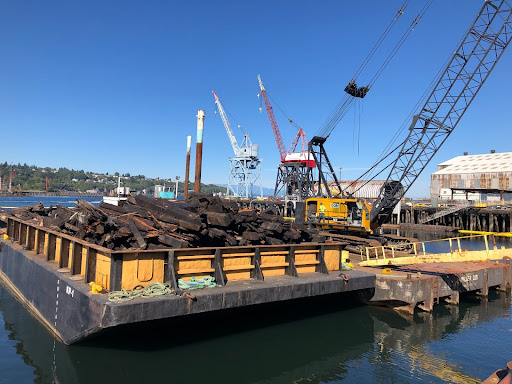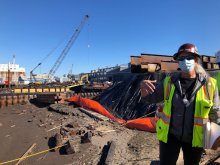Lower Duwamish River Southwest Yard Habitat Project Begins, Will Provide Almost 3 Acres of Fish and Wildlife Habitat
November 19, 2021
This summer, Vigor Industrial LLC (Vigor) began construction of the Southwest Yard Habitat Project to restore Chinook salmon and other species’ habitat along the Lower Duwamish River. This 2.7-acre project benefits natural resources including fish, shorebirds, and other wildlife that were injured from direct or indirect exposure to releases of hazardous substances or discharges of oil in this industrial waterway over decades. The off-channel marsh, intertidal, and riparian habitats to be created will help support the recovery of these injured resources. This project resulted from a settlement with Vigor Industrial LLC and Exxon Mobil Corporation valued at $48.4 million and a restoration plan, both finalized in May of this year. Vigor assumed liability related to the Harbor Island shipyard with its purchase of Todd Shipyards in 2011.
Before habitat is created, existing overwater structures, such as old docks and creosote pilings, must be removed. The Southwest Yard Habitat Project, in conjunction with Vigor’s West Waterway Habitat Bench Project (collectively called the Vigor Shipyards Habitat Projects), is anticipated to result in the removal of almost 6,000 creosote-treated pilings and 2.7 acres of overwater coverage. This year, the project will focus on removing these structures to make way for new habitat.
This project is a major milestone for the Elliott Bay Trustee Council, a group of state and federal agencies and tribes restoring Elliott Bay and the Lower Duwamish River. Members of the Elliott Bay Trustee Council include the National Oceanic and Atmospheric Administration (NOAA), the U.S. Department of the Interior, the Muckleshoot Indian Tribe, the Suquamish Tribe, and the State of Washington.
In September, the Trustee Council visited the site, following CDC guidelines, to see habitat restoration in progress, including:
- In- and over-water industrial structure removal
- Contaminated soil and sediment removal
- Upland excavation.
These are the early activities associated with construction of high quality habitat for salmon and other species to use, in an industrial area significantly lacking these features. Construction is being implemented by Orion Marine Contractors, under contract to Vigor.
Following completion of the habitat construction, Vigor will also restrict shipyard vessel activity in the project’s vicinity, with an emphasis on limiting activity from March 1 through June 30 of each year, to reduce impacts to migrating salmon. Construction is expected to be completed by the end of June 2023, when the new habitat will be ready for use by salmon and other species. The project also requires Vigor to perform 10 years of active maintenance and monitoring to ensure habitat establishment. After this 10-year period, Vigor will continue to perform maintenance and provide long-term stewardship of the site.
The Southwest Yard Habitat Project creates a unique opportunity to increase our understanding of the impact of habitat restoration on salmon and their food sources within an industrial landscape. Through a new partnership between Vigor, the University of Washington’s Wetland Ecosystem Team, and Long Live the Kings, a team of scientists will monitor habitat function before and after restoration to understand any changes that may occur in the quantity of vegetation, insects, and fish at the site. This research should help inform future restoration efforts along working waterfronts and support further efforts towards salmon recovery.








